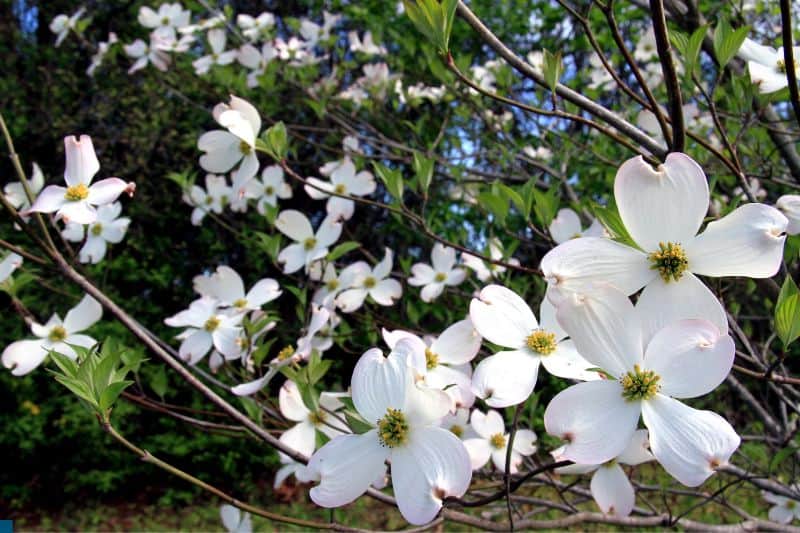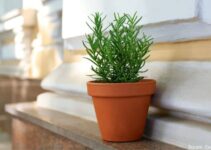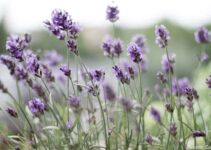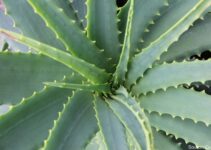Dogwood trees are some of the most common and loved flowering trees throughout the United States by homeowners and landscapers alike. These beauties are stunning throughout the seasons and offer both stunning blooms and unique foliage. But what happens when you notice your dogwood tree is in distress? Why are the leaves of my dogwood tree curling?
Read: Are Coffee Grounds Good For Dogwood Trees?
Causes of Curling Leaves on Dogwood Trees
Dogwood trees curl or cup their leaves when they are experiencing stress. This could be a pest infestation, disease, or environmental causes. Aphids, powdery mildew, and leaf scorch are the most common reasons dogwood trees curl their leaves.
Luckily, all of these are fairly easy and simple to remediate, especially if they are caught early enough.
For aphids, treating the leaves with an insecticide or horticulture oil will help rid your plant of these nasty pests. Keep an eye out for early signs of aphids, as they are so small they can be hard to see.
Aphids suck the sap from the leaves and can usually be found on the underside of the leaves. Generally, if caught early enough, no permanent damage will be done to your tree.
Powdery mildew isn’t going to kill your dogwood tree, but it can still cause the leaves to curl, turn brown, and fall off. It also can damage other plants or trees and can easily spread, so it’s best to remediate it quickly and efficiently.
You can treat the plant with an antifungal spray. Also, be sure that the tree isn’t overcrowded and has enough room for proper air circulation. Remove extra branches if necessary.
Leaf scorch is most likely the cause of curling dogwood tree leaves if you see no signs of powdery mildew or aphids. Leaf scorch is caused when the sun is too hot for the leaves. Unfortunately, if the leaves are curling because of too much sun or drying winds, there isn’t much you can do.
However, if they are experiencing leaf scorch, it could also be due to lack of water or inadequate soil, which can be easily remediated.
How Do You Know That Dogwood Tree is Dying?
Very few things are as disheartening as when you notice something is off with your trees. Whether they are large or small, removing a dying tree can be expensive and time-consuming.
However, leaving a compromised tree creates the risk of it falling over and damaging property or, worse, hurting people or animals. Luckily, dogwood trees show signs of problems long before they would need to be removed.
When it comes to dying dogwood trees, you may notice wilting foliage, cracking or peeling bark, infected or discolored leaves, and holes in stems or branches. These signs should be taken seriously, and action should be taken immediately to attempt to save the tree.
These signs are associated with a specific problem, and understanding and diagnosing the cause of the decline of the tree is the first step in saving it. Wilting is a sign of poor drainage, while cracked stems are associated with dry soil.
Holes in the leaves, stems, or branches of your dogwood tree show a pest problem, and fungal disease will show up as poor health, discolored leaves, and usually a layer of white mildew. An all-around unhealthy-looking plant can be a sign of poor pH in the soil.
How to Revive a Dying Dogwood Tree?
Having a distressed dogwood tree can be nerve-wracking, especially when you look at the financial cost and the effort required to remove a dead tree from your yard or landscape. Luckily, dogwood trees that look diseased or dying may be distressed and can be revived quickly and efficiently.
Once you have identified the cause of distress in your dogwood tree, you can begin looking for solutions. Each solution will be specific to the issue at hand for your dogwood tree.
Remember that dogwood trees grown near one another could have the same problem or multiple problems at once. Generally, environmental factors like soil pH, sun exposure, wind, and lack of water will affect any trees in the same vicinity.
Reviving a dogwood tree that has pests like aphids will require a pesticide or horticulture oil to kill and prevent new pests from attacking the plant. Since aphids spread easily to other plants, it’s best to treat anything that is growing near the infested dogwood.
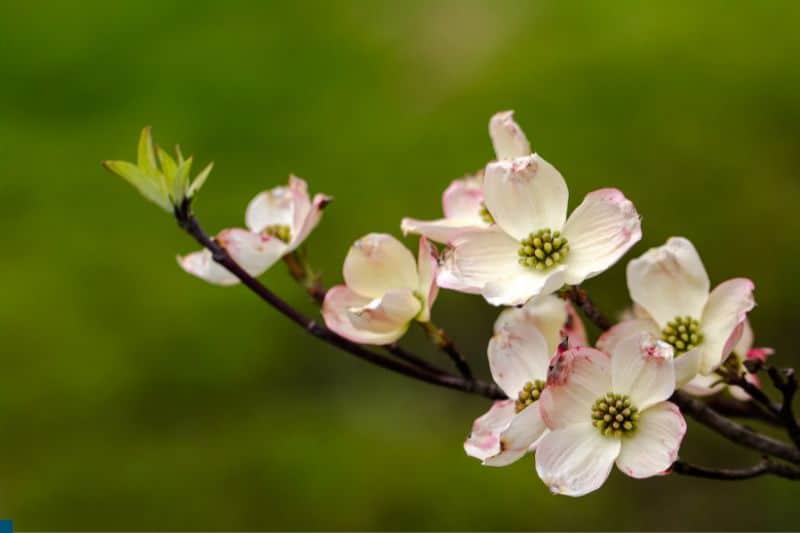
If your dogwood tree isn’t showing signs of a fungal infection like powdery mildew, remove the infected branches and spray the rest of the tree with an antifungal spray. This will remove the immediate fungal infection and help create more ventilation to prevent future infections from starting.
Be sure to carefully dispose of the fungus-infected branches and never throw them in your compost pile, as this can spread the infection to other plants.
When the tree isn’t retaining enough moisture, adding a layer of mulch around the base of the tree can help. This will help keep the sun from evaporating extra water and keep the soil cool. Water frequently and deeply for about 3 weeks to help a dried-out dogwood tree.
If you notice the pH of the soil seems off, you can add fertilizers. This will help improve the quality of the soil and give the tree the nutrient boost it needs to hopefully get out of its slump and back into its prime.
How to Care for a Damaged Dogwood Tree?
Caring for a damaged dogwood tree is crucial to help prevent insect infestations. Every spring, be sure to check your tree over for any signs of damage or peeling bark. Taking the time to inspect the tree properly can save you the headache of dealing with an infected or infested tree later in the season.
If you notice damage to the bark of your dogwood tree, use a sharp knife sterilized with alcohol to peel back the bark around the wound. Once the wound is clean, apply a generous amount of denatured alcohol to the wound with a clean cloth.
This will clean and disinfect the wound to help prevent disease or rot. After cleaning the wound, use a clean and sanitized paintbrush to add tree paint or shellac to cover the wound.
The tree paint or shellac will act as a bandage and barrier between the tree and the outside world. You can find it, as well as denatured alcohol, at your local hardware or paint store.
Be sure to keep a watchful eye on it. Your dogwood tree throughout the season. If it begins to show any signs of rot or decay, repeat the steps again, cutting back the infected bark, cleaning the wound, and applying tree paint.
Can a Dogwood Tree be Overwatered?
Dogwood trees can be overwatered. Dogwood trees prefer well-draining soil, and growing them in soil that holds too much moisture can lead to problems like root rot. Generally, it’s best to do infrequent but deep watering sessions for mature dogwood trees.
If you are worried about your dogwood tree drying out, especially during the hottest parts of the summer, mulching around the base of the tree can help the tree retain moisture without frequent watering sessions.
How Do You Know If a Dogwood Tree is Getting Too Much Water?
If you notice your dogwood tree leaves beginning to cup or curl, you may think that the tree needs water. However, too much water can be a problem for your tree as well. From root rot to fungal infections to pests, access to water can create a number of issues for dogwood trees. So, how do you know if a dogwood tree is getting too much water?
To tell if a dogwood tree needs water, use a screwdriver or other sharp tool and stick it into the soil. If the soil feels dry and the screwdriver comes out clean, the dogwood could use water.
Another way to tell if it’s time to water your dogwood tree is to use a small shovel and remove about 5 inches of dirt. If the soil seems dry, it’s time to water. If the soil seems overly wet or muddy, the tree is probably getting too much water.
Read: When Do Dogwood Trees Bloom?
Do Dogwood Trees Like Full Sun or Shade?
Dogwood trees can be grown in partial shade or full sun. While the tree will grow in the shade, it won’t bloom there. Grow your dogwood tree in full sun for the best chance at big, bold, and full blooms.
In their natural habitat, dogwood trees are often grown under the canopy, meaning they don’t receive a lot of bright direct light. Since they are naturally shade tolerant, many people like to plant their dogwood in the shade. While they will survive in shady areas, they need full sun to bloom the best.
If you don’t want to plant your dogwood tree in full sun, morning sun and afternoon shade also work great. This option works well for gardeners or homeowners growing their dogwood trees in regions that are extremely hot in the summer, like the southern or western parts of the United States.
